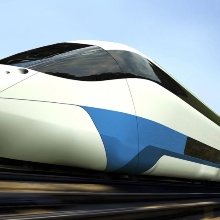In contrast, inductive energy transmission has the following advantages for railway vehicles:
- Overhead lines, sliding contacts, and current collectors which contribute to wear, noise emission, and aerodynamic resistance can be omitted.
- Inductive energy transmission systems are segmented for high power and thus have a redundant design so that failing subsystems only reduce the maximum transmission power but do not lead to a failure of the overall system. This opens up new possibilities for condition-based maintenance.
- In combination with a distributed drive, carriages can be moved autonomously, e.g. in the shunting area.
- Inductive energy transmission systems can also be used to transmit data. This opens up completely new prospects for train protection systems.
Therefore, the IEW is already involved in several, partly international cooperations with inductive energy transmission of trains. In cooperation with the German Aerospace Center, for instance, research is being conducted on a concept for the train of the future. The "Next Generation Train" is to achieve a cruising speed of up to 400 km/h and the required performance in the megawatt range is to be provided inductively. Research at IEW focuses on the development of highly efficient contactless power transmission systems by optimizing coil arrangements and reactive power compensation as well as the design of the necessary power electronics.




